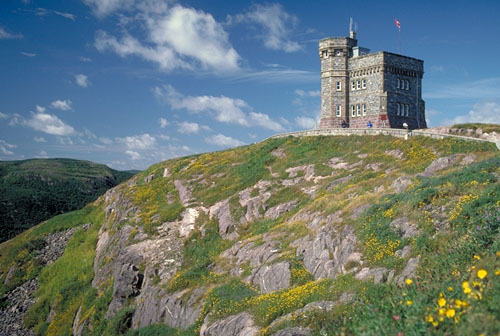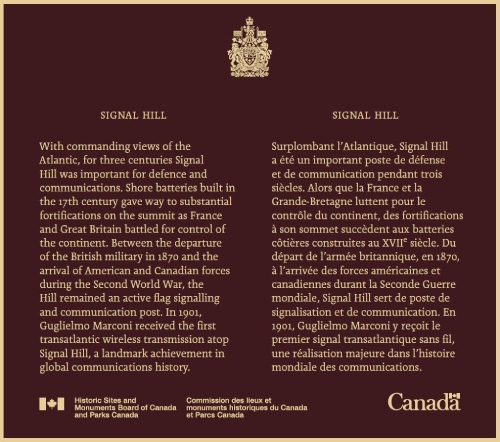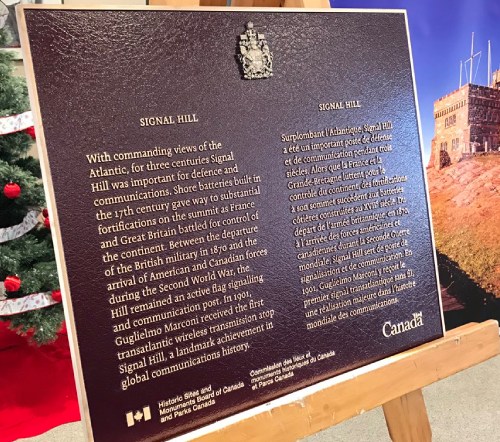Signal Hill National Historic Site

Signal Hill was designated as a national historic site in 1951.
Commemorative plaque: 230, Signal Hill Road, St. John's, Newfoundland and Labrador
Signal Hill
With commanding views of the Atlantic, for three centuries Signal Hill was important for defence and communications. Shore batteries built in the 17th century gave way to substantial fortifications on the summit as France and Great Britain battled for control of the continent. Between the departure of the British military in 1870 and the arrival of American and Canadian forces during the Second World War, the Hill remained an active flag signalling and communication post. In 1901, Guglielmo Marconi received the first transatlantic wireless transmission atop Signal Hill, a landmark achievement in global communications history.
Signal Hill
With its summit reaching roughly 167 metres above sea level, Signal Hill offers commanding views of the Narrows, a channel through which all ships must pass when entering St. John’s Harbour from the Atlantic Ocean. This site was important for communications and defence. Its fortifications defended St. John’s harbour for centuries and it was atop the Hill in 1901 that Guglielmo Marconi received the first transatlantic wireless transmission.

© Parks Canada / F. Bergeson / NFPO Collection / 011
In the 17th century, European ships regularly travelled to the northeastern coast of North America for fishing, whaling, and in the hopes of trading with the Innu, Inuit, and Beothuk. In the 1660s, local fishermen and residents constructed some of the earliest defensive works in the Narrows. Later, as France and Great Britain each tried to assert control in North America, the British constructed more substantial defences along the Narrows, at the base of Signal Hill, and eventually on the summit. There were brief periods of French occupation in 1696, 1705, 1709, and 1762. After the Battle of Signal Hill, the British strengthened their fortifications by building Fort Amherst and Fort Townshend.
After the departure of the British military in 1870, the Hill remained an active flag signalling and communication post that supported the rise of St. John’s as a commercial centre. Mercantile ships entering the Narrows used flags to identify themselves to signalmen on the Hill who, in turn, warned work crews at the docks. This system remained in use until 1958. During the Second World War, Canadian and American forces occupied the Hill and the Narrows as they prepared to defend St. John’s and North America in the Battle of the North Atlantic.


In 1901, Marconi received the first transatlantic wireless transmission atop Signal Hill, a landmark achievement in global communications history. He installed his apparatus in a former hospital and used a kite to raise his antenna. On December 12, he was able to pick up a message in Morse code transmitted from Poldhu, Cornwall (England). Decades later, the Canadian Marconi Company used Cabot Tower as a base for experiments and as a telegraph station, which it ceded to the Canadian Department of Transport in 1949.
Today, the firing of the noon day gun, which dates back to at least 1842, evokes the historical role of Signal Hill in communications and defence.
Backgrounder last update: 2017-09-27
The National Program of Historical Commemoration relies on the participation of Canadians in the identification of places, events and persons of national historic significance. Any member of the public can nominate a topic for consideration by the Historic Sites and Monuments Board of Canada.
Related links
- Date modified :